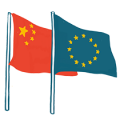

Ageing China seeks opportunity abroad
In March, Italy signed an agreement pledging its support for China’s trans-continental Belt and Road Initiative. Rome hopes Chinese companies will invest in the country’s ageing infrastructure, while critics worry about China’s perceived geopolitical ambitions. However, Beijing's push has to be seen in a larger context: an important driver of its outbound ambitions is the interaction of economic and demographic change at home. Faced with an ageing society, China is looking for investment opportunities in countries with younger populations along the BRI.
Since launching its “reform and opening” agenda in 1979, China has re-shaped the world economy. For the first three decades, China’s industrialization was driven by a low-wage demographic dividend. Falling birth and mortality rates boosted the working-age population share and kept wages low. Chinese leaders took full advantage, and the export of low-cost manufactured goods led to an industrialization revolution.
But that boom was always going to be temporary. As powerful as China’s leaders may be, even they cannot make China’s population structure youthful again overnight or undo the effect of rising education levels on wages. The first signs that the flow of low-wage migrant workers into manufacturing hubs was beginning to slow came in 2003 – and China’s working-age population share has been falling steadily for about a decade now.
Adding to these supply-side pressures on the labor market, demand for China’s exports never quite recovered from the shock of the global financial crisis of 2008, which itself coincided with a peaking workforce in many Western economies. Compounding this double challenge was over-investment: China’s mostly state-owned steel mills and selective other industry-intensive sectors now have spare production capacity.
These pressures have shifted the attention of China’s leaders away from low-wage industrialization. Their focus is now on providing for the needs of a growing number of pensioners and ensuring appropriate jobs are available for young people. Not only are there fewer new labor-market entrants than forty years ago, they also have different skills and often top-quality university degrees. In principle, they should prove more productive – they will have to be, just to maintain output as the working-age population share continues to fall. But the transition to such higher-skilled jobs can be fraught.
Demographic pressure drives China's outbound engagement within BRI
These pressures help explain why China is encouraging Chinese companies to invest in labor-saving technology and innovative sectors at home and, crucially, in infrastructure and selective manufacturing industries abroad. The latter is in principle good news for any developing country that offers an investor-friendly business environment and a population structure that promises a demographic dividend – much as did China four decades ago.
It happens that many countries around the shores of the Indian Ocean - Bangladesh, India, Indonesia, Tanzania - are, compared to other regions, relatively well positioned to take advantage of China’s new interest in investing abroad. Many of these countries host key ports that also serve land-locked neighbors. And Indian Ocean countries are also home to more than two billion people, mostly young. It is the world’s youngest region, one in which newly paved roads and newly built bridges would boost economic output and demand.
The logic of President Xi’s Belt and Road Initiative has stirred debate since its launch in Kazakhstan and Indonesia in 2013. In Indonesia, strategically important to both the Indian and Pacific Oceans, he spoke of a “Maritime Silk Road of the twenty-first century”. But beyond China’s history in the region, economic demography surely plays a role: Rapid population ageing across East Asia makes Indian Ocean countries a strategically located reservoir of low-wage workers - and a potentially vast emerging consumer market.
Countries are looking at the demographic-dividend window that China already profited from
Some of the region’s largest economies – including India, soon to become the world’s most populous country - are looking at the kind of demographic-dividend window that China started profiting from in the 1980s. These countries, like China before them, will best make sure they also profit should foreign investors reap the dividends of investment and economic growth. To do so, they will need to develop policies and institutions according to their own conditions to deal with and profit from rapid economic change.
With China already investing in infrastructure and selective industries in a growing number of these countries, economic rivalry with Western industrialized countries grouped in the Organization for Economic Development (OECD) is nascent. But the Indian Ocean region has started a nascent process of greater intra- and inter-regional cooperation through the Indian Ocean Rim Association (IORA).
In addition to China, IORA dialogue partners include Egypt, France, Germany, Japan, the UK, and the USA. China’s interest in the Indian Ocean, now under the umbrella of the Belt and Road Initiative, is influenced by changes in its economic demography and development level. China’s demographics-related logic in the intended belts and roads might broadly be something for other countries also experiencing rapid population ageing to respond to as well, in their own style. Italy is among them.
Readers having enjoyed this blog can find further information here:
Johnston, L.A. (forthcoming 2019). The Economic Demography Transition: Is China’s ‘not rich, first old’ circumstance a barrier to growth? Australian Economic Review (to be published in 2019 volume)
Johnston, L.A. (2019) An economic demography explanation for China’s ‘Maritime Silk Road’ interest in Indian Ocean countries. Journal of the Indian Ocean Region, 15:1, 97-112, DOI: 10.1080/19480881.2019.1569326
